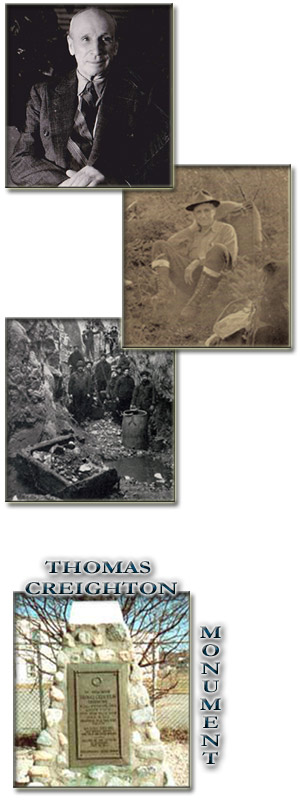Tom Creighton was born in Barrie, Ontario. Little is known of his early life, but his adventurous spirit eventually led him north. It is known that he was commercial fishing at Candle Lake in 1911. Perhaps it was here that he first met Dan Mosher, who was homesteading in the Paddockwood area, just north of Prince Albert. They joined forces, and using Tyrell's favorable geological reports, began prospecting in northern Saskatchewan.
The prospectors used the railroad to reach the Pas, and from there they traveled west down the Saskatchewan River to Cumberland House, north across Namew Lake to Sturgeon Landing and finally navigated the Sturgeon Weir River to arrive at Fort Henry, a Hudson Bay Post on the southern shores of Amisk Lake.
It was while prospecting in this area in 1913 that Creighton and his partners (Dan & Jack Mosher, Leon & Isadore Dion & Dan Milligan) found gold on the northwest side of Amisk Lake. This triggered Saskatchewan's first gold rush and soon over a 1000 prospectors were in the area hoping to "hit pay dirt". In response to this activity, J.E. Hammell, a mining promoter for Ontario, had plans of developing a community (Beaver City) adjacent to the post.
Businessmen in Prince Albert who had backed Tom Creighton & Dan Mosher made large profits on these staking activities. They quickly established The Beaver Lake Gold Mining Company and began working the property. Tom Creighton ended his relationship with this group because they were more interested in developing a paying gold mine than seeking out additional claims.
Creighton and his partner spent most of that winter hauling mining and milling equipment from The Pas to Beaver City. It was after breakup that they returned to the mineralized outcrop on the east side of what they later named Flin Flon Lake. After some preliminary work they realized that they had found a large low-grade copper sulphide deposit.
Tom Creighton was now forced to look for a new partner. Jack Hammell, always the opportunist, was quick to step up and offer his services. Jack Hammell and Tom Creighton believed in each other. This belief would take them from gold on Amisk Lake to the copper sulfides of Flin Flon Lake and beyond.
In 1914, however, Jack Hammell desperately needed producing mine properties to sustain his investment in Beaver City. Creighton and his partner expanded their search to include copper as well as gold because demands of WW1 had caused huge increases in copper prices.
According to William E. Dodds (who claimed to have been present), it was December 1914 when Tom Creighton stopped at David Collins' camp on Athapapuskow Lake. Collins showed him rock samples from a mineralized outcrop on his trap line. Creighton was so interested in these samples that he asked to be taken to the site. Tom Creighton staked a claim on this property in January 1915.
The group, which included Jack Hammell, had visions of mining the property themselves, but the ore body was extremely complex and costly to develop. They soon realized that they would require large amounts of outside capital and began searching for new investors. To prevent a staking rush (such as what happened at Amisk Lake ), they kept the discovery to themselves. In May 1915, Dan Mosher went to Toronto and returned with Frank Currie (a former partner in the Otisse-Currie Mine at Elk Lake). Jack Hammell replaced Dan Mosher as the group's negotiator with outside investors, and between 1915 and 1922, this property was held by, or was under option to, numerous mining concerns.
They must have felt time and luck were running out, as one investor after another abandoned them. Isadore Dion and Dan Milligan sold their interest in 1918. Hammell and Creighton held on until 1922 and then sold to the "Complex Ore Recoveries Company".
After selling his share, Tom Creighton didn't retire, but continued to seek out new adventure and spent the latter part of his life in the community that was named for him. There is a cairn on the Creighton School grounds that is dedicated to him and it reads:
"His wants were few, His habits simple, The bush his wide domain."
|


